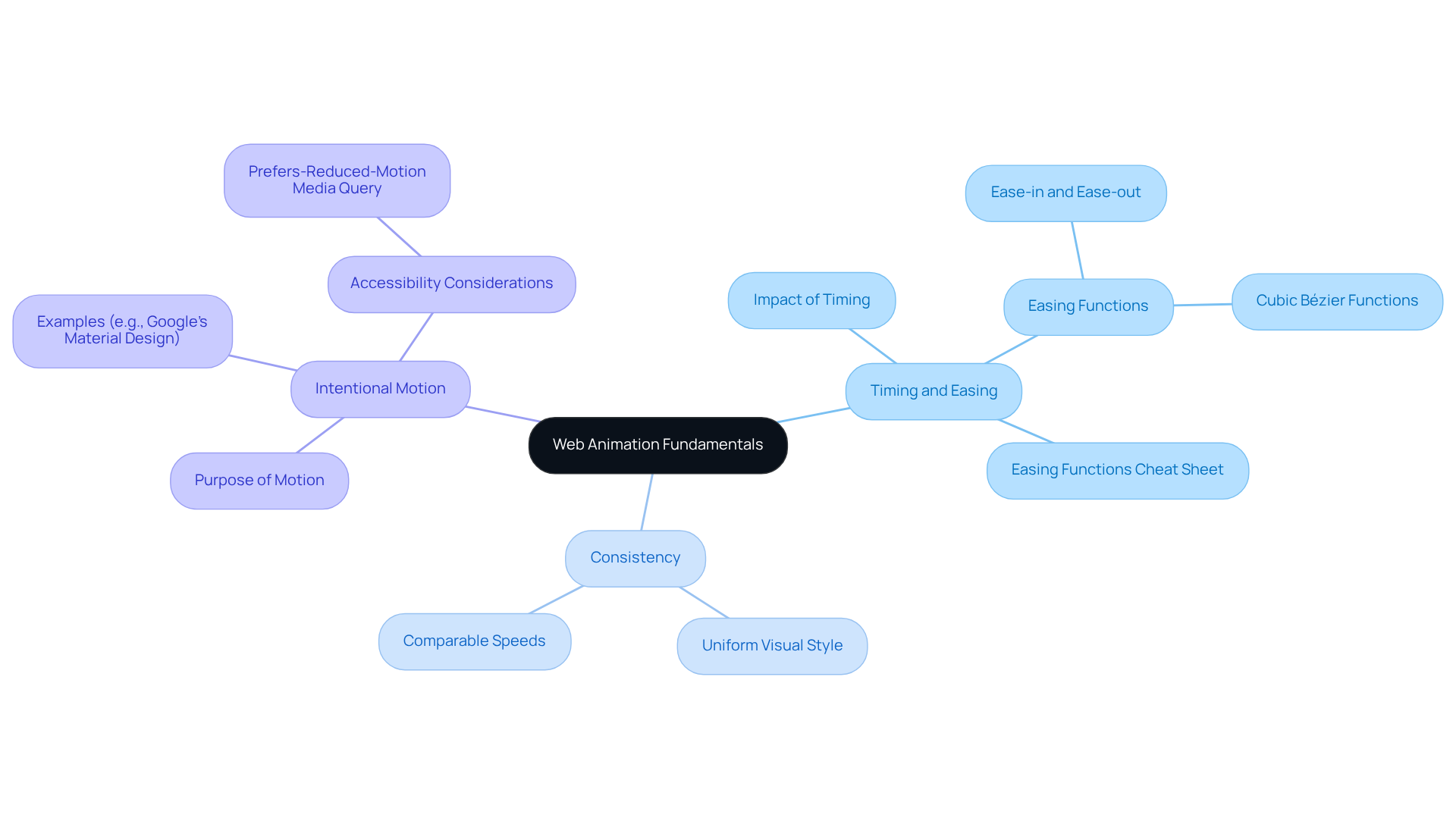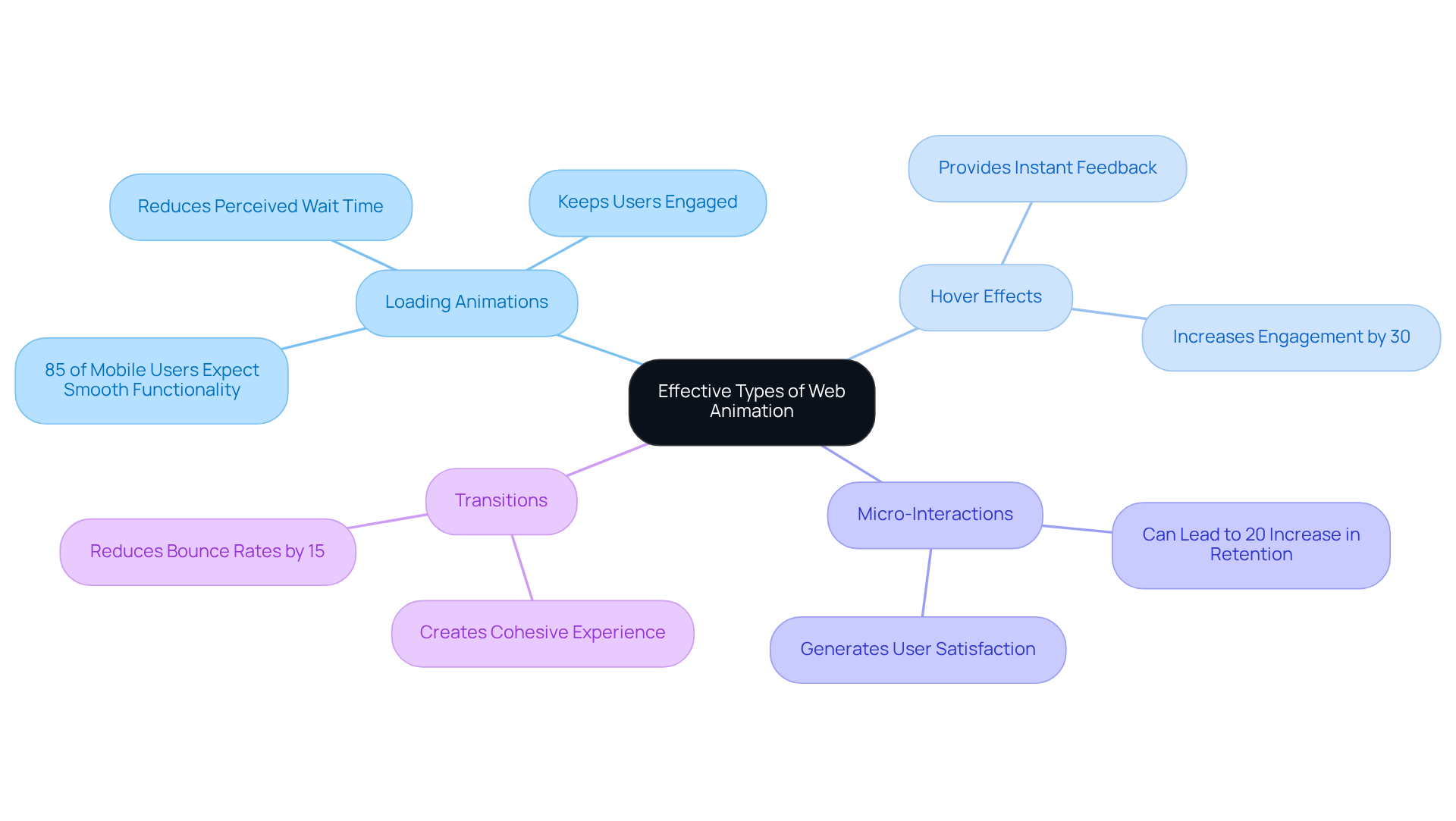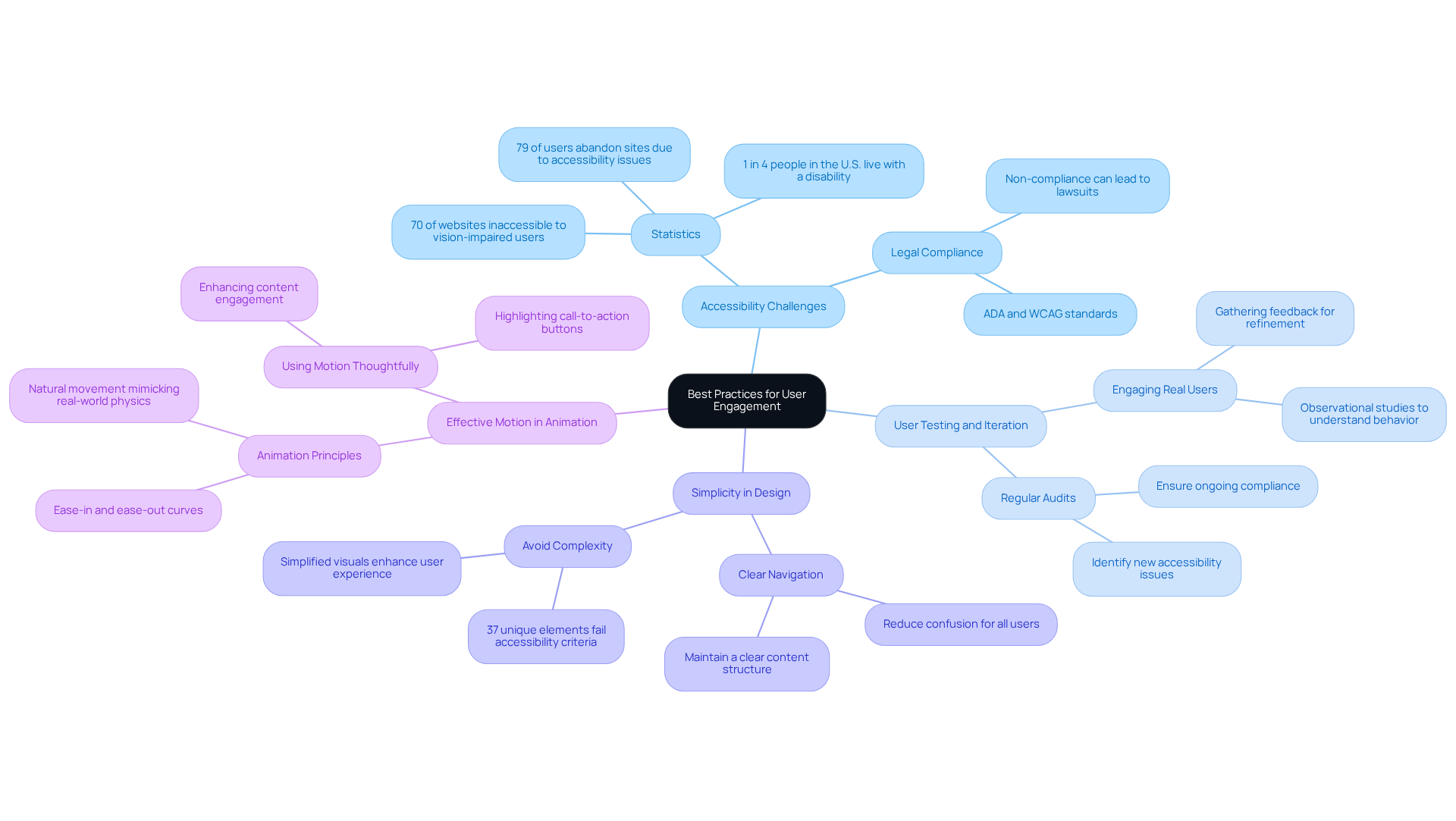Overview
Web animation can be a challenge for many, as it plays a crucial role in enhancing user experiences. When timing, consistency, and intentional motion are not effectively employed, interactions can feel disjointed and frustrating. This can lead to decreased user retention and satisfaction, making it vital to address these issues.
However, the good news is that well-executed animations, such as loading visuals and micro-interactions, can significantly improve these experiences. By focusing on accessibility and simplicity in design, we can create engaging and intuitive interactions that resonate with users.
It’s about nurturing a connection, ensuring that every animation serves a purpose and enhances the overall experience. Let’s embrace these principles together, fostering a supportive environment where users feel valued and understood.
Introduction
Web animation has truly transformed the way users engage with digital content, infusing life into static designs and enriching user experiences. Yet, many designers face the challenge of mastering effective animation principles. It’s not just about creating captivating visuals; it’s about guiding users seamlessly through their online journeys.
As user needs grow increasingly complex and accessibility challenges arise, a pressing question emerges: how can designers ensure their animations serve a meaningful purpose without overwhelming or alienating their audience? This is where a nurturing approach becomes essential, allowing designers to connect with their users and create animations that resonate deeply.
Understand Web Animation Fundamentals
Web animation can be a challenge for many designers, as it utilizes movement to enrich interaction and improve the overall experience on websites. It’s important to understand how to effectively implement this to truly connect with users. Key principles include:
- Timing and Easing: Recognizing the impact of timing on user perception is crucial. Easing functions, like ease-in and ease-out, can make movements feel more organic and intuitive. Research indicates that individuals are 60% more likely to remember animated visuals compared to static ones, underscoring the importance of proper timing in capturing attention. For those looking to implement these functions effectively, the Easing Functions Cheat Sheet, which contains 30 useful function presets, can be a valuable resource.
- Consistency: Maintaining a uniform visual style throughout a website promotes a cohesive experience for visitors. This means using comparable speeds and easing functions across the site, which helps users navigate smoothly without confusion.
- Intentional Motion: Each motion should serve a clear purpose—whether it’s guiding users, providing feedback, or enhancing storytelling. Unnecessary visuals can , leading to a negative interaction. For instance, Google’s Material Design framework exemplifies how deliberate transitions, particularly regarding timing and easing, can foster responsive and intuitive interactions, setting a standard for effective web animation and design. Moreover, it’s essential to consider accessibility; utilizing the prefers-reduced-motion media query allows designers to offer alternatives for those with motion sensitivity, ensuring that visual effects enhance rather than hinder the interaction.
By mastering these fundamentals, designers can craft visuals that not only elevate aesthetics but also significantly enhance functionality and engagement. This approach helps avoid the common pitfall of over-engineering effects that can overwhelm users. Remember, your goal is to create an inviting and supportive experience for everyone who interacts with your designs.

Explore Effective Types of Web Animation
Web visuals are crucial in enhancing user experience, making interactions not only captivating but also intuitive. Many tech startup founders face the challenge of keeping users engaged, especially in a digital landscape where attention is fleeting. This can be frustrating, but effective types of web animation can significantly improve user engagement and create a more satisfying experience.
Loading Animations can be a lifeline during those moments when content is loading. Spinners or progress bars keep users engaged, effectively reducing the perceived wait time. Studies reveal that individuals are more likely to stay on a site when web animation is present, as it provides essential visual feedback during delays. In fact, 85% of mobile device owners expect interactive web content to operate smoothly on their devices. This underscores the importance of loading visuals in maintaining audience engagement.
Web animation, such as hover effects, also plays a vital role in enhancing interactivity. These subtle movements in web animation, activated by user hovers, offer instant feedback. Imagine buttons that change color or size upon hovering—these not only draw attention but also encourage clicks. Research indicates that web animation, including hover effects, can boost engagement by up to 30%. As Steve Jobs wisely stated, "Design is how it works, not just how it looks," reminding us of the practical significance of these visual effects.
Micro-interactions are a small yet impactful form of web animation that engages users. These web animations respond to user actions, like a heart icon filling in when liked, generating a sense of satisfaction. Design specialists suggest that well-executed micro-interactions in web animation can lead to a 20% increase in audience retention.
Transitions are equally important; web animation allows for between states or pages, helping users navigate the interface effortlessly and creating a cohesive experience. For instance, fading in new content or sliding elements into view can make a world of difference. Effective transitions in web animation can reduce bounce rates by up to 15%, thereby helping to maintain visitors' interest. A case study on the impact of interactive web design highlights that such features can enhance retention rates by up to 60%, further emphasizing their significance.
By thoughtfully integrating these forms of visuals, designers can create a more engaging and instinctive experience for users, leading to greater satisfaction and retention. Moreover, with 72% of online consumers considering a mobile-friendly site essential for making purchases, enhancing visuals for mobile platforms is not just beneficial—it's essential for success. Together, we can transform the digital landscape into a more inviting and user-friendly space.

Implement Best Practices for User Engagement
To create animations that truly resonate with users, it's essential to recognize the challenges many face in accessing digital content. Accessibility is not just a checkbox; it’s a vital aspect of design that can significantly impact user experience. When we consider that nearly , the urgency becomes clear. Unfortunately, the reality is stark: 70% of websites in sectors like government, news, and e-commerce remain inaccessible to individuals with vision impairments. This not only limits their engagement but also diminishes the overall effectiveness of the site. By prioritizing accessibility in web animation, we can ensure that all users benefit from our visuals, enhancing usability for everyone.
Regular testing and iteration are crucial in this process. Engaging with real users to gather feedback helps us understand their experiences and refine our web animation. It’s alarming to note that up to 79% of users may abandon a site due to accessibility issues. By employing analytics to gauge engagement and adapting visuals based on user behavior, we can foster stronger connections with our audience.
Simplicity is key. Overly complex visuals can confuse rather than clarify. Research shows that the average web page contains 37 unique elements that fail accessibility criteria. By embracing straightforward designs, we can create more impactful visuals that guide users effectively, enhancing their overall experience.
Moreover, let’s harness motion as a tool to enrich content rather than merely embellish it. Thoughtful web animation, such as highlighting a call-to-action button, can significantly increase user engagement. As Norman McLaren wisely stated, "Animation is not the art of drawings that move but the art of movements that are drawn." By making informed design choices, we can cultivate a deeper emotional connection with our users, reinforcing the importance of storytelling in visual art.
By embracing these best practices, we can craft web animations that not only beautify our platforms but also elevate user engagement and satisfaction. Together, let’s commit to creating a more inclusive digital landscape where everyone feels valued and connected.

Conclusion
Mastering web animation presents a challenge for many designers, yet it is essential for creating engaging user experiences that truly resonate with visitors. When designers grasp the fundamentals and implement best practices, they can transform static interactions into dynamic journeys that captivate users and enhance functionality. It’s important to recognize that thoughtful and intentional use of animation not only beautifies a website but also significantly improves user engagement and satisfaction.
Throughout this discussion, we’ve highlighted key principles such as timing and easing, consistency, and intentional motion as foundational elements that contribute to effective web animation. Moreover, various types of animations—including loading animations, hover effects, and micro-interactions—serve as vital tools for maintaining user interest. It’s crucial to remember the importance of accessibility and simplicity in design, reminding us all of the need to create inclusive experiences for every user.
As we reflect on the significance of web animation, we see that it cannot be overstated. In a rapidly evolving digital landscape, embracing best practices for web animation is not just beneficial; it’s crucial for fostering deeper connections with users. By prioritizing accessibility, conducting regular testing, and simplifying designs, web designers can create inviting environments that engage and satisfy users. The call to action is clear: let’s commit to enhancing user experiences through thoughtful web animation, ensuring that every interaction is meaningful and memorable. Together, we can create a more engaging and inclusive online world.
Frequently Asked Questions
What are the fundamental principles of web animation?
The key principles of web animation include timing and easing, consistency, and intentional motion. These elements help enhance user interaction and improve the overall experience on websites.
Why is timing and easing important in web animation?
Timing and easing significantly impact user perception. Easing functions like ease-in and ease-out make movements feel more organic and intuitive. Research shows that animated visuals are 60% more memorable than static ones, highlighting the importance of proper timing in capturing attention.
How can designers ensure consistency in web animation?
Designers can ensure consistency by maintaining a uniform visual style across the website, using comparable speeds and easing functions. This helps create a cohesive experience for users and facilitates smoother navigation.
What does intentional motion mean in the context of web animation?
Intentional motion refers to ensuring that each animation serves a clear purpose, such as guiding users, providing feedback, or enhancing storytelling. Unnecessary animations can distract or confuse users, leading to negative interactions.
How does Google’s Material Design framework relate to web animation?
Google’s Material Design framework exemplifies effective web animation through deliberate transitions that focus on timing and easing, fostering responsive and intuitive interactions. It sets a standard for how animations can enhance user experience.
What should designers consider regarding accessibility in web animation?
Designers should consider accessibility by using the prefers-reduced-motion media query to offer alternatives for users with motion sensitivity. This ensures that visual effects enhance interactions without causing discomfort.
What is the ultimate goal of implementing web animation effectively?
The ultimate goal is to create an inviting and supportive experience for users, enhancing both aesthetics and functionality while avoiding over-engineering effects that may overwhelm them.




